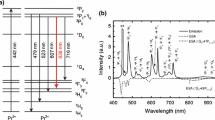Abstract
A novel algorithm, calling FDTD-based overlapping integral-RK method, is proposed to analyze Er-Yb co-doped phosphate glass IR waveguide amplifiers. This new method is derived from the combination of Finite-Difference Time-Domain(FDTD), overlapping integral and RK method. First the normalized eigen-fields of signal and pump lights in Er-Yb co-doped phosphate glass waveguide are calculated by FDTD algorithm, and then the overlapping integrals between light fields and the distribution of Er3+(Yb3+) concentrations are obtained, finally the distributions of powers of signal and pump along waveguide are calculated by RK method. Gain performance of IR waveguide amplifiers is obtained from calculated signal power. Comparison of the simulation result with an experiment is given, it demonstrates that this new algorithm is valid and shows good agreement with experimental results.
Similar content being viewed by others
References
[1] S. F. Wong, E. Y. B. Pun, and P. S. Chung, “Er3+-Yb3+ codoped phosphate glass waveguide amplifier using Ag+-Li+ ion exchange,” IEEE Photon. Technol. Lett., vol.14, pp.80–82, 2002.
[2] Chen Haiyan, Liu Yongzhi, Dai Jizhi,etal. “Modeling and simulation of saturation gain of IR integrated photonic amplifiers,” International Journal of Infrared and millimeter waves, vol.25, pp1791–1798, 2004.
[3] H.Y.Chen, Y.Z.Liu, and J.Z.Dai, “Er3+/Yb3+ co-doped phosphate glass waveguide amplifier,” IEEE 2002 International conference on communications circuits and systems proceedings(ICCCAS ‘02), pp.827–829. Chengdu, P.R. China,2002,
[4] Chen haiyan, Liu Yongzhi, Dai Jizhi, and Yang Yapei, “High Gain and Broad band optical waveguide amplifiers,” Microwave and Optical Technology Letters. Vol. 42, pp64–66, 2004
[5] K.C. Reichmann, P.P. Iannone, M. Birk, N.J. Frigo, D. Barbier, C. Cassagnettes, T. Garret, A. Verlucco, S. Perrier, and J. Philipsen, “A eight-wavelength 160-km transparent metro WDM ring network featuring cascaded erbium-doped waveguide amplifiers,” IEEE Photon. Technol. Lett.,vol.13, pp.1130–1132,2001.
[6] Fabrizio Di Pasquale, Maurizio Zoboli, “Analysis of Erbium-Doped Waveguide Amplifiers by a Full-Vectorial Finite-Element Method,” IEEE J.lightwave Technol., Vol. 11, pp1565–1573, 1993
[7] F. Caccavale, F. Segato, I. Mansour, “A numerical study of erbium doped active LiNbO3 waveguides by the beam propagation method,” J. Lightwave. Technol., Vol. 15, pp2294–2300,1997
[8] W. Huang and R. R. A. Syms, “Analysis of folded erbium-doped planar waveguide amplifiers by the method of lines,” J. Lightwave Technol., Vol. 17, pp2658–2664, 1999.
[9] Yu Z., Gao LM, Wei W.,etal, “Numerical analysis of amplification characteristic of erbium-doped waveguide amplifier by FD-BPM,” Optical and Quantum Electron., Vol. 36, pp321–330, 2004.
[10] J.A.Vallés, J.A.Lázaro, M.A.Rebolledo, “Modeling of integrated erbium-doped waveguide amplifiers with operlapping factors methods,” IEEE J. Quantum Electron., Vol.32, pp1685–1694, 1996.
[11] Kenji Kawano and Tsutomu Kitoh, “Introduction to Optical Waveguide Analysis: Solving Maxwell’s Equations and Schrödinger Equation,” John Wiley & Sons, Inc, pp233–248, 2001.
Author information
Authors and Affiliations
Corresponding author
Rights and permissions
About this article
Cite this article
Chen, H. Simulation of IR Waveguide Amplifiers Using FDTD-Based Overlapping Integral-RK Method. Int J Infrared Milli Waves 26, 555–562 (2005). https://doi.org/10.1007/s10762-005-4072-z
Received:
Published:
Issue Date:
DOI: https://doi.org/10.1007/s10762-005-4072-z




